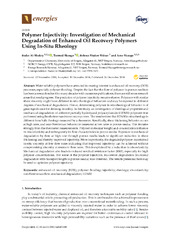| dc.contributor.author | Al-Shakry, Badar | |
| dc.contributor.author | Skauge, Tormod | |
| dc.contributor.author | Shaker Shiran, Behruz | |
| dc.contributor.author | Skauge, Arne | |
| dc.date.accessioned | 2019-05-23T11:52:54Z | |
| dc.date.available | 2019-05-23T11:52:54Z | |
| dc.date.issued | 2018-12-24 | |
| dc.Published | Al-Shakry B, Skauge T, Shaker Shiran B, Skauge A. Polymer Injectivity: Investigation of Mechanical Degradation of Enhanced Oil Recovery Polymers Using In-Situ Rheology. Energies. 2018;12(1):49 | eng |
| dc.identifier.issn | 1996-1073 | en_US |
| dc.identifier.uri | https://hdl.handle.net/1956/19707 | |
| dc.description.abstract | Water soluble polymers have attracted increasing interest in enhanced oil recovery (EOR) processes, especially polymer flooding. Despite the fact that the flow of polymer in porous medium has been a research subject for many decades with numerous publications, there are still some research areas that need progress. The prediction of polymer injectivity remains elusive. Polymers with similar shear viscosity might have different in-situ rheological behaviors and may be exposed to different degrees of mechanical degradation. Hence, determining polymer in-situ rheological behavior is of great significance for defining its utility. In this study, an investigation of rheological properties and mechanical degradation of different partially hydrolyzed polyacrylamide (HPAM) polymers was performed using Bentheimer sandstone outcrop cores. The results show that HPAM in-situ rheology is different from bulk rheology measured by a rheometer. Specifically, shear thickening behavior occurs at high rates, and near-Newtonian behavior is measured at low rates in porous media. This deviates strongly from the rheometer measurements. Polymer molecular weight and concentration influence its viscoelasticity and subsequently its flow characteristics in porous media. Exposure to mechanical degradation by flow at high rate through porous media leads to significant reduction in shear thickening and thereby improved injectivity. More importantly, the degraded polymer maintained in-situ viscosity at low flow rates indicating that improved injectivity can be achieved without compromising viscosity at reservoir flow rates. This is explained by a reduction in viscoelasticity. Mechanical degradation also leads to reduced residual resistance factor (RRF), especially for high polymer concentrations. For some of the polymer injections, successive degradation (increased degradation with transport length in porous media) was observed. The results presented here may be used to optimize polymer injectivity. | en_US |
| dc.language.iso | eng | eng |
| dc.publisher | MDPI | en_US |
| dc.rights | Attribution CC BY | eng |
| dc.rights.uri | http://creativecommons.org/licenses/by/4.0 | eng |
| dc.subject | enhanced oil recovery (EOR) | eng |
| dc.subject | Polymer flooding | eng |
| dc.subject | injectivity | eng |
| dc.subject | rheology | eng |
| dc.subject | viscoelasticity | eng |
| dc.subject | non-Newtonian flow | eng |
| dc.subject | mechanical degradation | eng |
| dc.subject | HPAM | eng |
| dc.title | Polymer Injectivity: Investigation of Mechanical Degradation of Enhanced Oil Recovery Polymers Using In-Situ Rheology | en_US |
| dc.type | Peer reviewed | |
| dc.type | Journal article | |
| dc.date.updated | 2018-12-26T13:06:22Z | |
| dc.description.version | publishedVersion | en_US |
| dc.rights.holder | Copyright 2018 The Author(s) | en_US |
| dc.identifier.doi | https://doi.org/10.3390/en12010049 | |
| dc.identifier.cristin | 1647187 | |
| dc.source.journal | Energies | |

